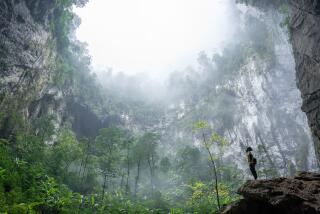Review: A boatload of ideas are packed into Simon Winchester’s literary cruise across Pacific Rim’s recent history
Simon Winchester begins his survey of the world’s biggest ocean with the world’s biggest travel-writer cliché: by contemplating the view from the window seat of a commercial airliner.
This seems an odd choice: Surely the “nose-to-the-porthole” trope, as Paul Theroux calls it, is beneath a writer of Winchester’s power and scope. But as the opening pages of “Pacific” unfold, it becomes apparent why he uses his flight from Honolulu to Guam as a device.
This book is meant to be wandering and bird’s-eyed; not a comprehensive treatment but an impressionist view, a history-by-milestone method used by David Halberstam’s “The Fifties” and Stefan Zwieg’s “Decisive Moments in History” (a work explicitly cited by Winchester as an inspiration). It is also a multiple-stop journey through the recent human history of this “oceanic behemoth of eye-watering complexity,” whose variety can be described through a series of visitations to the places around its rim.
The planet’s biggest body of water, Winchester points out in a soaring moment, “is the most biologically diverse, the most seismically active; it sports the planet’s greatest mountains and deepest trenches; its chemistry influences the world; and the planetary weather systems are born within its boundaries.”
Despite these striking geographic extremes, Winchester gives the physical aspects of his subject rather short treatment. Only a chapter on undersea volcanism really explores the natural world.
Instead, the book concerns itself with human events around the ocean where “the dirty business of the modern world has been conducted” and where the U.S. now stands in uneasy polarity with its potential future rival, China.
Most of Winchester’s anecdotes therefore unfold on land. His 12 chapters meld Pacific Rim geography with what he calls “moments” that illustrate his broader themes of globalization, violence and the attempted control of the unpredictable ocean since Jan. 1, 1950.
After that date, U.S. atomic tests on Pacific atolls threw elevated levels of carbon-14 in the atmosphere, mangling the precision of carbon dating dead plants and animals. Researchers came to classify any readings made after New Year’s Day of 1950 as suspect. This radiochemical shift from purity to corruption leads into the book’s first — and most disturbing — chapter.
Willfully forgetting the horrors of Hiroshima, the U.S. defense cadre had an attitude about atomic research best described as “Red paranoia meets gee-whiz.” Americans, having painstakingly fought their way island to island the decade before, decided to test the new hydrogen bomb on a postcard-pretty island called Bikini.
A midlevel officer named Col. Ben Wyatt was sent out (with a newsreel crew) to prod the inhabitants into leaving, asking them, finally, with biblical overtones, “Would you be willing to sacrifice your island for the welfare of all men?” Residents left their homeland for a desiccated nearby island called Rongerik where they nearly starved. The nuclear explosion sank 10 decommissioned ships and vaporized two others, scattering radioactive seawater all over the remaining vessels and island. A U.S. official shrugged it off, telling reporters, “We goofed.” Technological exuberance announced itself with a mushroom cloud but left a legacy of human arrogance and an island permanently soaked in atomic poison.
Not everything here is this bleak. A section on Japan’s postwar transistor revolution describes the “messianic clarity” of Sony’s co-founder, Masaru Ibuka, who foresaw a boom in radios and tape recorders and who gets far less credit in Big Tech’s pantheon of heroes than his charismatic partner, Akio Morita.
The men concocted the word “Sony” — derivative of the Latin word for “sound” — which also recalled the easy nickname “Sonny,” which had been tossed around Tokyo by occupying American soldiers. Japanese precision craftsmanship soon created a transpacific trade in devices that tickled the senses. Small radios were soon tucked into breast pockets all over the U.S.
Winchester is at his most entertaining in a chapter on the Polynesian pastime of riding waves on long wooden boards, “a swelling, joy-filled grace quite unimaginable in all prior experience.” A visiting Jack London, of all people, wrote about this in Woman’s Home Companion in 1907 and gave flattering mentions of a Waikiki lifeguard named George Freeth, who was soon doing demonstrations off the Southern California coast at Venice and Huntington Beach. Local surf culture has many influences, but this was the biggest breaking top.
If anyone has earned the right to run a victory lap around the sea, it’s Winchester, now 71, a former foreign correspondent for the Guardian whose previous books have been about many Pacific-related topics: the explosion of Krakatoa, the physics of tsunamis, his hike through the Korean peninsula, the 1906 San Francisco earthquake and the history of Chinese science.
While Winchester primarily gathers his material from about 200 books listed in the bibliography, his first-person presence comes in recollections from 40 years of reporting, adding authority and panache to the narrative. One footnote about paddling a kayak to the center of the crater of volcanic Mt. Pinatubo is especially entertaining. He also writes with incisive anger about the condition of North Korea, a place he knows better than just about any Westerner.
Winchester has prodigious gifts as a popular historian and an explainer of faraway events. His book is an admirable portrait of what lies beyond the gray sheet off California’s edge, an unquiet realm increasingly at the center of 21st century history.
::
Pacific: Silicon Chips and Surfboards, Coral Reefs and Atom Bombs, Brutal Dictators, Fading Empires and the Coming Collision of the World’s Superpowers
Simon Winchester
Harper: 512 pp., $28.99
Zoellner is an associate professor of English at Chapman University and the author of the book “Train: Riding the Rails that Created the Modern World, from the Trans-Siberian to the Southwest Chief.”
More to Read
Sign up for our Book Club newsletter
Get the latest news, events and more from the Los Angeles Times Book Club, and help us get L.A. reading and talking.
You may occasionally receive promotional content from the Los Angeles Times.







